
Two hundred and twenty-five years ago, on December 17, 1790, one of the wonders of the Western Hemisphere, the Aztec calendar stone, or solar stone, was uncovered beneath the ground by workmen renovating Mexico City’s Zócalo, or central plaza. Intricately carved from basalt (solidified lava), it measures 11 feet, 8 inches in diameter, 3 feet thick, and weighs nearly 25 tons. The artist carved the Aztec calendar stone in 1479 CE, less than 50 years before the Spaniards came to Mexico, and dedicated it to the sun god. It was lost – buried under the central square ofMexico City – for almost 300 years.
The massive carving, which originally held a place of reverence in the Great Temple of the Aztecs, renewed interest in Mexico’s ancient cultures, a generation before Mexico won its independence from Spain.
For a while it remained on display in the western tower of the Metropolitan Cathedral, and in 1885 it was moved to the Museo Nacional de Antropología in Mexico, where it remains to this day.
The famous stone, one of the most iconic images of Mexico and often reproduced in facsimile form, is a brilliant combination of artistry and geometry. It reflects the Aztec understanding of time and space as wheels within wheels. The detailed surface of the stone combines the understanding of the gods the indigenous people had created over the centuries as well as their observations of the heavens.
Calendar 1 – The Xiuhpohualli
The first calendar of the Aztec people was called the xiuhpohualli, the counting of years. This was a 365-day year, helpful for planning the agricultural cycle and predicting the weather. There were 18 months, each 20 days long, with four 5-day weeks. Then to bring the year up to 365 days there were 5 “unlucky” days added. Each year was divided into four seasons.
With the addition of a 12-day New Fire ritual every 52 years, the exact length of the years was remarkably close to that of the solar year that modern scientists calculate.
Calendar 2 – The Tonalpohualli
Though both calendars inter-relate in religion and ceremony, it’s the tonalpohualli that is considered the sacred calendar. The rituals were all divided up among the gods.
There were 20 signs, and 13 numbers. Like a gear within a gear, each of the 20 signs would be assigned each of the 13 numbers. Thus 13×20=260, the total number of days in the “sacred year.” The 13-day period is a kind of Aztec week. Not only was every day ruled by a god, but each weekwas also ruled by a god – the one associated with the first day.
Every 52 years, the two calendars would align. This could bring disaster on the world, so a special ritual took place called the New Fire Festival.
Creation, at least the most recent creation, took place on the date known as 13-reed (sometime around 1011 CE).
Find out today’s date, or your birthday according to the Aztec calendar stone on this site!
More on the background and origins of the Aztec calendar.
Read more about how the Aztec calendar wheels work!
Adapted from Aztec-History.com.
Photo: A colored representation of the Aztec calendar stone.












Comments